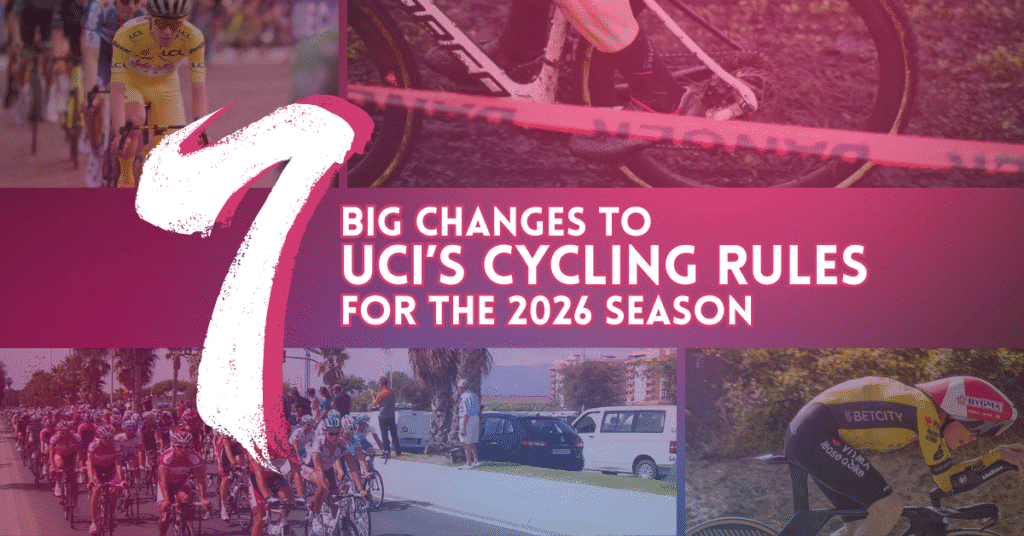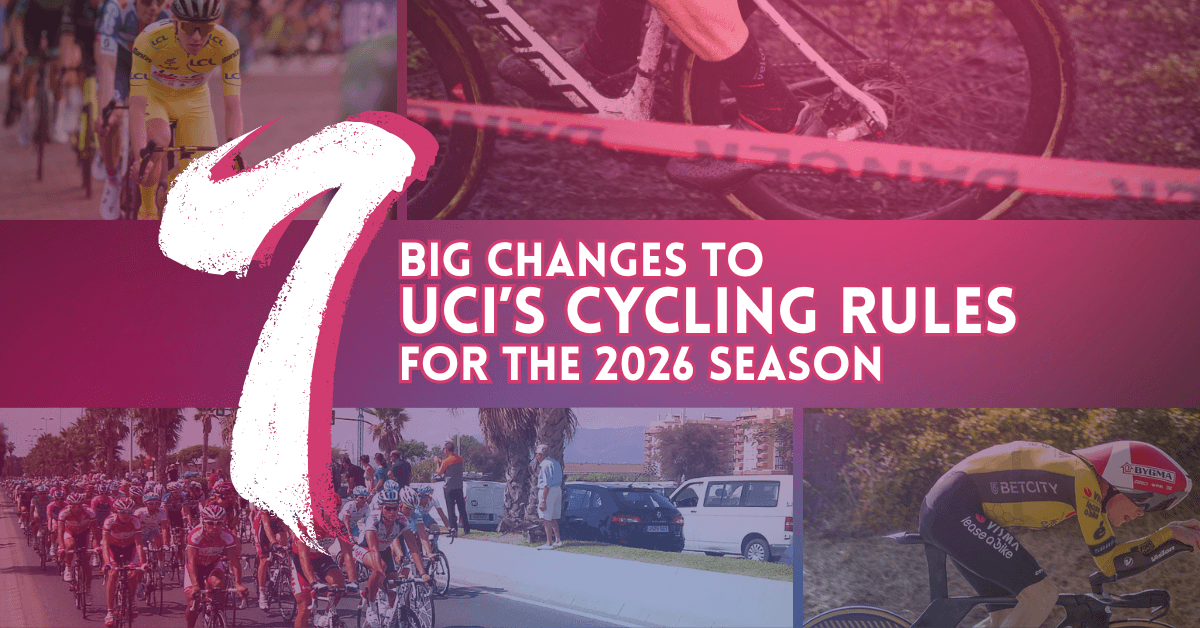Each year, the Union Cycliste Internationale (UCI) makes changes to the rules, regulations, and race schedule for professional cycling, from the WorldTour level down. But which of these changes do you need to know about as a viewer and fan? Let’s take a peek and preview the seven biggest changes on the docket for 2026 and beyond.
World Champs brought a chance to seal some deals on cycling regulations for 2026 and beyond.
The UCI management held its usual meeting at the Road World Championships in Rwanda and put its final stamp of approval on quite a few changes to be implemented in the world of road cycling from 2026 onward. Their discussions took place over three days and covered a range of topics, including rider safety, health, and race scheduling.
The previous meeting of the committee included some approvals and proposals; this time, the committee approved most of these measures, so we’re certain to see them put into action starting next year (or later, as the proposals dictate.)
You can read the press release detailing the full changes here.
Embed from Getty ImagesBut… will fans really notice?
Which changes are we likely to notice as fans? Much of the UCI’s inner workings might fly overhead of the average cycling viewer. Even I, humbly unpacking a few of these rule changes for you through this post, admit that most of these changes don’t matter to the audience experience.
However, a few can be interesting anyway, and have broad-enough reaching implications within the sport that they might spark your interest… whether or not you notice them in the first races of the season.
Ready to take a look? Without further ado, here are the outcomes of seven UCI decisions (made in Rwanda and previously) to get ready for road season in 2026:

Here are 7 major changes to UCI WorldTour cycling taking effect in 2026 and beyond:
1. The women’s Giro will visit Italy in the spring.
First off, some great news: we’re seeing both men’s and women’s maglia rosa in the springtime this year. The women’s Giro d’Italia (Giro Donne) is moving forward in the calendar to be temporally connected to the men’s race. It will now start the last weekend of the men’s in late May.
This change is a surprise because of the murmurings of moving the men’s Giro to the fall. Snow presents more of a problem in Italy through the spring. However, it’s also part of a larger effort to streamline, clarify, and highlight the women’s racing calendar. Previously, the Giro Donne was held during the men’s Tour de France, which could decrease viewership.
The women’s Tour de France also gets a minor move this year, and will now take place one weekend after the men’s Tour finish in Paris. It makes much more sense to give some breathing room between these two major events, and hopefully the ladies’ race will see the biggest viewership since it restarted in 2022.
2. The Tour De Suisse gets demoted.
On the men’s side, a surprise change may mix up how riders prepare for the Tour de France. The Tour de Suisse, which has historically been eight or more stages in length, will be shortened to just five stages starting in 2026.
The stage race will take place from June 17th to June 21st, with races for both men’s and women’s categories held simultaneously.
Additionally, organizers intend to start and finish stages from the same location. This change was made for sustainability purposes by preventing unnecessary travel. Race runners have also suggested they’d like to incorporate more circuits to build a fun fan atmosphere during the race.
What does this mean for riders? While this has traditionally been a good buildup for July, riders may gravitate towards other, longer races instead, like the Criterium du Dauphine. It’s also unclear whether the new Tour de Suisse will hold the same prestige or interest among riders. For example, Primož Roglič has won all major one-week races aside from the Tour de Suisse, but will he need to win the new less-than-one-week TdS to complete his palmares? We’ll see!
Read more: Discover why pre-Tour de France performances don’t always equal big moves in July.
3. The Classic Brugge-De Panne rebrands with a fresh new name.
Last year, UCI organizers added a new one-day race, the Copenhagen Sprint in Denmark. This race was met with a positive reaction from both fans and riders.
This year, they’re hoping to capitalize off the success of this new addition by giving a facelift to a pre-existing race: the Classic Brugge-De Panne. This race will be retitled as the Ronde van Brugge and will start and finish in Bruges, March 25th and 26th for the women’s and men’s races respectively. The new parcours will also feature a sprint finish, just like Copenhagen Sprint.
Was Brugge-De Panne not popular? Actually, this is the second time they’ve tried to jazz up this specific classic, as it was previously rebranded in 2021 from the Three Days of Bruges-De Panne. Now De Panne is out of the picture entirely.
At least it appears that the race organizers aren’t going full cheesy, as it was originally thought that the new name was going to be “The Great Sprint Classic”… I tend to agree that calling something “great” doesn’t necessarily mean it’s great! However, a race around Bruges does sound great, so best of luck to the organizers with the rebrand efforts.
4. A win for the little guys: top ProTeams are now invited to all WorldTour stage races.
When teams are invited to races can seem opaque to cycling fans, but happily (for both fans and ProTeams riders), the UCI has made things much simpler starting in 2026. Now, the top three ProTeams from the previous year will automatically get invitations to ALL UCI WorldTour stage races. This includes the Grand Tours: the Giro, Tour, and Vuelta.
The end result of this new regulation is that 23 teams will be guaranteed to participate in cycling’s top events. This includes the 18 WorldTour teams, the 3 ProTeams, and the two “wildcards” selected by race organizers.
Interestingly, women’s cycling already uses an approach similar to this for granting invitations. It should be interesting to see how this works out on the men’s side. The best outcome is that it reduces disparity between WorldTour teams and ProTeams, increasing visibility for ProTeams riders and sponsors.
5. Mountain biking and cyclocross will soon mean more for UCI rankings.
This change won’t take place until 2027, but it’s official: points earned in other disciplines of cycling, including cyclocross and mountain biking, will now count towards UCI points totals for road cycling. This new rule only applies to the team ranking, and also only for the top 20 men and top 8 women in any given team.
For some teams, this won’t make a difference… but it could give a competitive edge to others. Alpecin-Deceuninck and Q36.5 are likely looking to capitalize off of Mathieu van der Poel and Tom Pidcock, who both participate in both cyclocross and mountain biking throughout the year. Visma Lease-a-Bike will also be hopeful to rake in some extra points from Wout van Aert and Marianne Vos competing in cyclocross during the winter months.
Will teams now be obligated to stay competitive in other disciplines beyond road cycling? It’s not clear. One of the best possible outcomes is that this change results in more visibility for lesser-known cycling disciplines. However, it could be that these points don’t amount to much in the end, so we’ll have to wait and see.
Embed from Getty Images6. Gear and safety updates (hopefully) make the sport less risky for both riders and fans.
Three major safety and gear regulations are making a splash next year, although some have been received well and others not.
Starting in 2026, a minimum handlebar width will be enforced for both road and time-trial bikes. This change is intended to regulate the kinds of aero positions that riders can take on the bike, but the one-size-fits-all approach has been criticized by teams and riders, especially on the women’s side of the sport. However, the UCI will go ahead with enforcing minimums starting in 2026 having taken some of these considerations into account.
Want to learn more about why this decision was so controversial? Check out the video from Tom Bowers on YouTube to learn more:
Another new rule forbids riders from wearing time trial helmets outside of time trial races or stages. Although TT helmets have become a relatively common sight in Grand Tour stages or even one-day races, all helmets will be required to have a certain level of ventilation going into 2026. Attached visors or helmet covers will also be limited for safety reasons.
Most relevant for race organizers are the new regulations surrounding barriers. The barriers in some previous races have been downright dangerous to riders, and now the UCI is stepping in to make some minimum standards. Dimensions for the barriers as well as the way they are fastened to each other and the road will now be taken into account. Most importantly, they now must be strong enough to withstand the impact of a crash, which should help to protect both riders and fans during high-speed accidents.
Read more: Why do “marginal gains” matter so much to the pros?
7. We’re not ready for OneCycling… at least, not yet.
There’s been a lot of talk about OneCycling, a new cycling league project led by Richard Plugge, the owner of Visma Lease-a-Bike. Most of the changes suggested within the scope of the project include ways to monetize the sport. It also comes tied to funding from Saudi Arabian backers and must include a new race in Saudi Arabia as a consequence, which has drawn criticism.
However, this year, the UCI rejected OneCycling’s proposal for changing the commercial structure of the sport. Instead, they’re leaving the door open to some of the more modest suggestions, such as overhauling the race calendar or adding additional races in the future.
Is this the end of OneCycling? Not so fast, because Plugge and other OneCycling supporters might not give up that easily. But the UCI is ready to force their hand if needed. Previously, the UCI president said that WorldTour teams that continue to entertain the idea of OneCycling could be stripped of their WorldTour licenses. Now, the WorldTour races are set through 2028, so we aren’t likely to see any OneCycling-inspired additions or changes until then. Let’s keep an eye out to see whether the UCI will double down on their threats or if they really do want to keep the dialogue open.
Embed from Getty ImagesWhich of these changes do you think you’ll notice most in 2026? Let us know your thoughts in the comments or on social media! ★










Leave a Reply